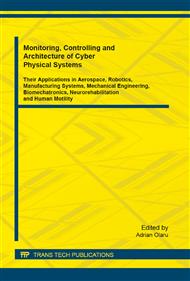[1]
G. H. Nanhore and M. M Bartere: Mobile Phone Sensing System for Health Monitoring, International Journal of Science and Research (IJSR). Volume 2, Issue 4 (2013), pp.252-255.
Google Scholar
[2]
D. Barata, G. Louzada, A. Carreiro and A Damasceno: System of Acquisition Transmission Storage and Visualization of Pulse Oximeter and ECG Data Using Android and MQTT, Procedia Technology. Volume 9, (2013), pp.1265-1272.
DOI: 10.1016/j.protcy.2013.12.141
Google Scholar
[3]
C. G. Scully, J. Lee, J. Meyer, A.M. Gorbach, D. Granquist-Fraser, Y. Medelson and K.H. Cho: Physiological Parameter Monitoring from Optical Recordings with a Mobile Phone, IEEE Transaction Biomedical Engineering, Volume 59, Issue 2 (2012).
DOI: 10.1109/tbme.2011.2163157
Google Scholar
[4]
O. Postolache, P.S. Girão, M. Ribeiro, M. Guerra, J. Pincho, F. Santiago and A. Pena: IEEE International Workshop on Enabling Telecare Assessment with Pervasive Sensing and Android OS Smartphone, in Medical Measurements and Applications Procedings (MeMeA)(2011).
DOI: 10.1109/memea.2011.5966761
Google Scholar
[5]
S.J. Jung, R. Myllylä and W.Y. Chung: Wireless Machine-to-Machine Healthcare Solution using Android Mobile Devices Global Networks, IEEE Sensor Journal. Volume 13, Issue 5 (2013) pp.1419-1424.
DOI: 10.1109/jsen.2012.2236013
Google Scholar
[6]
E. Burnette, Hello, Android: Introducing Google's Mobile Development Platform (Pragmatic Programmers), Pragmatic Bookshelf Ed., Nov. (2009).
Google Scholar
[7]
S. Emarose, R. Asokan and D. Valayaputtur: Continuos Monitoring Heart Rate Variability and Heamondynamic Stability of an Automobile Driver to Prevent Road Accidents, Third International Conference on Computing Communication & Networking Technologies (ICCCNT), (2012).
DOI: 10.1109/icccnt.2012.6395936
Google Scholar
[8]
N. Geva, Y. Geva and Y. Tal, U.S. Patent 20, 130, 070, 043. (2013).
Google Scholar
[9]
C. Gabaude, B. Baracat, C. Jallais, M. Bonnaiaud and A. Fort: Cognitive Load Measurement While Driving, HFES Europe Chapter Conference Toulouse, (2007).
Google Scholar
[10]
A. Riner, A. Ferscha and M. Aly: Heart on the Road: HRV Analysis for Monitoring a Driver's Afective State, in Proceedings of the 1st International Conference on Automotive User Interfaces and Interactive Vehicular Applications, (2009).
DOI: 10.1145/1620509.1620529
Google Scholar
[11]
Y. Sun, X. Yu, J. Berilla, Z. Liu and G. Wu: An in-Vehicle Physiological Signal Monitoring Sistem for Driver Fatigue Detection, Submitted to the 3rd International Conference on Road Safety and Simulation (2011).
Google Scholar
[12]
K. Han, M. Jung and J. Cho: Implementation of the Personal Health Care Service on Automotive Environments, Personal and Ubiquitous Computing, Volume. 18, Issue 3 (2014), pp.523-533.
DOI: 10.1007/s00779-013-0672-0
Google Scholar
[13]
D. Parekh: Design Heart Rate Blood Pressure and Body Temperature Sensors for Mobile on-Call Sistem, , PhDr thesis, Department of Electrical and Computer Engineering, McMaster University (2010).
Google Scholar
[14]
S. Behbahani and M. A. Pishbin: New Oxygenation Method Based on Pulse Oximeter, American Journal of Biomedical Engineering, Volume 2, Issue 4 (2012) pp.185-188.
DOI: 10.5923/j.ajbe.20120204.06
Google Scholar
[15]
O. O. Ogunduyile, O.O. Oludayo and M. Lall: Healthcare Monitoring System Using a Collection of Sensor Nodes, International Journal of Advanced Research in Computer Science & Technology, Volume 3, Issue 2 (2013), pp.632-639.
Google Scholar
[16]
J. Achten and A. E. Jeukendrup: Heart Rate Monitoring, Sports Medicine, Volume 33, Issue 7 (2003), pp.517-538.
DOI: 10.2165/00007256-200333070-00004
Google Scholar
[17]
P. Palatini: Need for a Revision of the Normal Limits of Resting Heart Rate, Hypertension (1999).
Google Scholar
[18]
M. Shafique, P. A. Kyriacou and S. K. Pal: Investigation of Photoplethysmographic Signal and Blood Oxygen Saturation Value in Healthy Volunteers During Cuff-Induced Hypoperfusion Using a Multimode PPG/SpO2 Sensor, in Medical & Biological Engineering & Computing, Volume 50, Issue 6 (2012).
DOI: 10.1007/s11517-012-0910-z
Google Scholar
[19]
S. L. Schultz: Oxygen saturation monitoring by pulse oximetry, AACN procedure manual for critical care (2001).
Google Scholar
[20]
J. L. Boulanger and Q. Ð. Van: Requirements Engineering in a Model-based Methodology for Embedded Automotive Software, IEEE International Conference on Research, Innovation and vision for Future (2008), pp.263-268.
DOI: 10.1109/rivf.2008.4586365
Google Scholar


